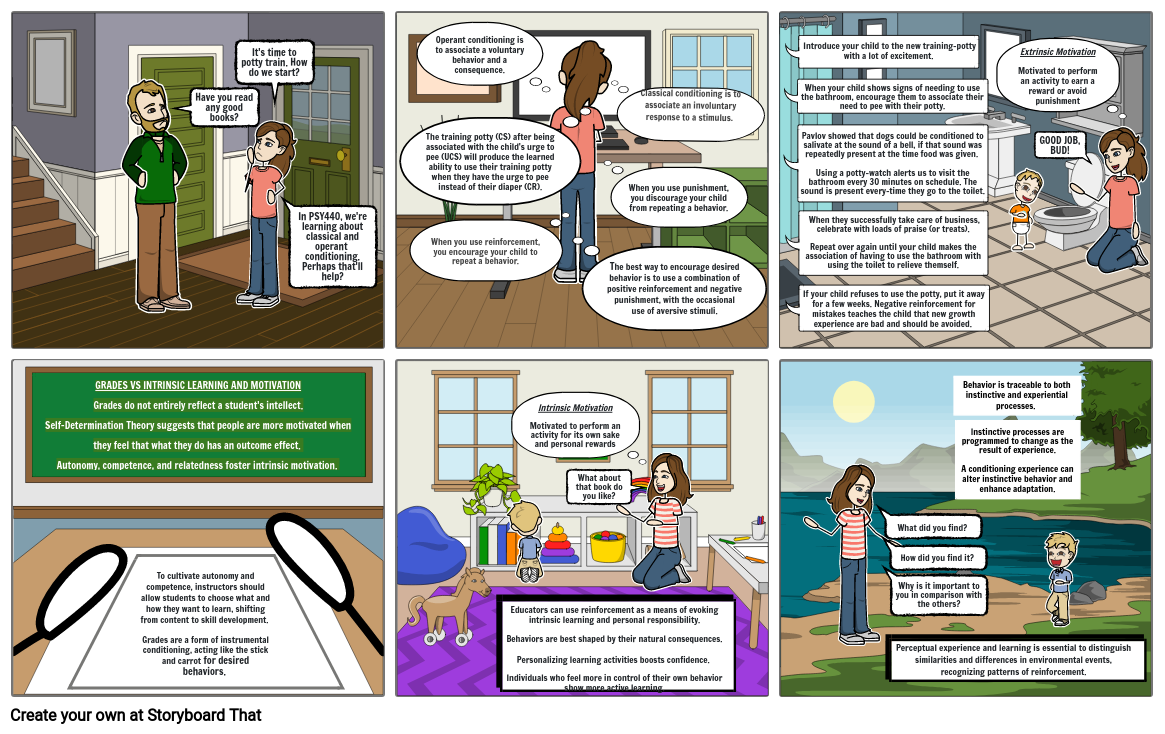Classical Conditioning and Potty Training

Storyboard Text
- Have you read any good books?
- It's time to potty train. How do we start?
- In PSY440, we're learning about classical and operant conditioning. Perhaps that'll help?
- When you use reinforcement, you encourage your child to repeat a behavior.
- Operant conditioning is to associate a voluntary behavior and a consequence.
- The training potty (CS) after being associated with the child's urge to pee (UCS) will produce the learned ability to use their training potty when they have the urge to pee instead of their diaper (CR).
- When you use punishment, you discourage your child from repeating a behavior.
- Classical conditioning is to associate an involuntary response to a stimulus.
- The best way to encourage desired behavior is to use a combination of positive reinforcement and negative punishment, with the occasional use of aversive stimuli.
- Pavlov showed that dogs could be conditioned to salivate at the sound of a bell, if that sound was repeatedly present at the time food was given. Using a potty-watch alerts us to visit the bathroom every 30 minutes on schedule. The sound is present every-time they go to the toilet.
- When your child shows signs of needing to use the bathroom, encourage them to associate their need to pee with their potty.
- Introduce your child to the new training-potty with a lot of excitement.
- When they successfully take care of business, celebrate with loads of praise (or treats). Repeat over again until your child makes the association of having to use the bathroom with using the toilet to relieve themself.
- If your child refuses to use the potty, put it away for a few weeks. Negative reinforcement for mistakes teaches the child that new growth experience are bad and should be avoided.
- Extrinsic MotivationMotivated to perform an activity to earn a reward or avoid punishment
- GOOD JOB, BUD!
- GRADES VS INTRINSIC LEARNING AND MOTIVATIONGrades do not entirely reflect a student's intellect.Self-Determination Theory suggests that people are more motivated whenthey feel that what they do has an outcome effect. Autonomy, competence, and relatedness foster intrinsic motivation.
- To cultivate autonomy and competence, instructors should allow students to choose what and how they want to learn, shifting from content to skill development. Grades are a form of instrumental conditioning, acting like the stick and carrot for desired behaviors.
- Educators can use reinforcement as a means of evoking intrinsic learning and personal responsibility.Behaviors are best shaped by their natural consequences. Personalizing learning activities boosts confidence. Individuals who feel more in control of their own behavior show more active learning.
- Intrinsic MotivationMotivated to perform an activity for its own sake and personal rewards
- What about that book do you like?
- What did you find?
- How did you find it?
- Why is it important to you in comparison with the others?
- Perceptual experience and learning is essential to distinguish similarities and differences in environmental events, recognizing patterns of reinforcement.
- Behavior is traceable to both instinctive and experiential processes.
- Instinctive processes are programmed to change as the result of experience.A conditioning experience can alter instinctive behavior and enhance adaptation.
Over 30 Million Storyboards Created

